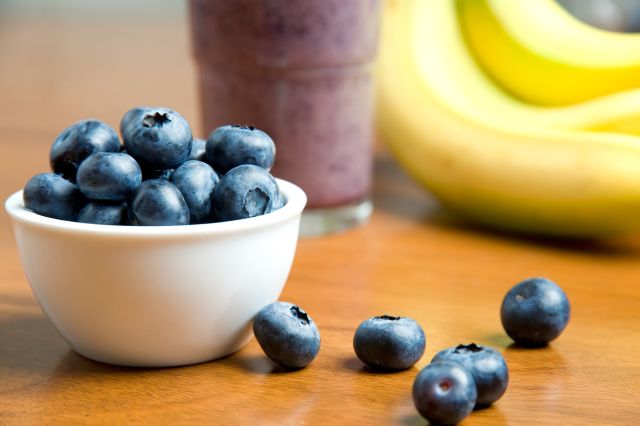Updated on June 21, 2024.
Keeping track of nutrition trends can make your head spin. One day, the latest superfood is the key to health and longevity. The next, headlines tell you to avoid the same food. (Coconut oil, anyone?)
But one food that consistently ranks atop the must-eat lists—and whose benefits are backed up by shelves of research—is the modest blueberry.
Blueberries are packed with healthy nutrients, fiber, and vitamins. They can be eaten fresh or frozen and add a sweet wholesomeness to all kinds of prepared foods and baked goods. When eaten regularly, they have been shown to help stave off a range of health conditions. If your fridge, freezer, or pantry are not stocked with these indigo gems, it’s time to add them to your shopping list.
North American gems
Native to North America, blueberries are the official state fruit of Maine, where they grow wild. Cultivated varieties can also be found in Michigan, Georgia, and the Northwest.
They get their distinctive blue hue from pigments known as anthocyanins, which increase to darken the berries as they ripen. Wild blueberries, also known as lowbush, have more anthocyanins than their cultivated counterparts, which makes them a slightly more nutritious option.
A little blue boost
Anthocyanins are flavonoids, members of a class of plant chemicals called phenolic compounds that are thought to contribute most of the antioxidant powers of blueberries. Antioxidants help the body by neutralizing the effects of free radicals, unstable chemicals that attack and damage the body’s cells.
Free radicals are created naturally by our bodies as part of normal biological processes, or by exposure to external factors like X-rays, hazardous chemicals, or cigarettes. The damage caused by free radicals—known as oxidative stress—may increase the risk of a range of health issues including cancer, high blood pressure, and heart disease, as well as neurological and inflammatory conditions. Antioxidants help protect against oxidative stress by boosting the immune system, detoxifying the liver, and repairing damaged DNA.
Blueberries are among the best sources of antioxidants of all fruits and vegetables. Beyond their antioxidants, one cup of raw blueberries contains the following key nutrients:
- Calories: 85.5
- Carbohydrates: 21.8 grams
- Fiber: 3.6 grams
- Vitamin C: 14.6 milligrams
A heart-healthy choice
Of all the benefits blueberries may offer, the most well-researched may be around heart health. Owing in large part to their antioxidant and fiber content, blueberries have been shown to help reduce high cholesterol, high blood pressure, artery stiffness, and inflammation.
A 2019 article in the American Journal of Clinical Nutrition looked at men with metabolic syndrome—a condition marked by health risks including large waistline, high blood pressure, high triglycerides, low HDL (aka “good” cholesterol), and high blood glucose levels. These factors contribute to increase one’s risk of heart disease. Researchers found that eating one cup of blueberries each day improved participants’ HDL levels and reduced the stiffness of their arteries. These improvements could reduce the risk of cardiovascular disease by as much as 15 percent, according to the study authors.
Other studies have shown that a steady diet of blueberries can help lower LDL (aka “bad” cholesterol) by as much as 28 percent over just two months. The fiber in blueberries has the effect of trapping cholesterol in the intestine and carrying it out of the body through bowel movements instead of letting the artery-clogging substance linger in the bloodstream.
Eating blueberries has also been shown to reduce blood pressure and lower the risk of atherosclerosis, or hardening of the arteries. The antioxidants in blueberries help reduce the occurrence of tiny injuries inside the arteries that give fatty plaques a foothold to form blockages. Anthocyanins are also vasodilatory—meaning they make blood vessels wider—which also helps reduce blood pressure.
Diabetes-friendly fruit
A regular dose of the phenolic compounds found in blueberries may help enhance insulin sensitivity, the body’s ability to draw sugar from the bloodstream and put it to use as energy.
In a 2022 meta-analysis published in Nutrition, Metabolism and Cardiovascular Diseases, researchers found that consuming blueberries and cranberries reduced blood glucose levels by 18 mg/dl and lowered glycated hemoglobin (a measure of average blood glucose levels over time) by 0.32 percent in people with diabetes. The same effects were not observed in people without diabetes.
Men with type 2 diabetes who ate blueberries for eight weeks had slightly lowered A1c levels compared to those who didn’t eat blueberries, according to a 2020 study published in Current Developments in Nutrition. (A1c is a measure of average blood glucose levels over the course of three months.) A large study published in 2013 in BMJ found that eating three servings a week of blueberries had a greater impact on lowering the risk of diabetes than any other fruit.
Blueberries’ health benefits are especially good news if you are overweight or obese or have other health factors that can boost your risk of insulin resistance, high blood sugar, and type 2 diabetes. In a 2017 study published in the American Journal of Clinical Nutrition, researchers looked at the flavonoid intake of British twins. Those under the age of 50 who ate foods high in anthocyanins had up to a 9 percent lower fat-mass ratio than the twins who didn’t eat these foods.
In another 2017 study published in the Journal of Functional Foods, overweight and obese adults received nutritional therapy for three months. Halfway through the study, participants replaced 50 grams of carbohydrates in their diet with 50 grams of blueberries daily. After 12 weeks, participants eating blueberries lost more weight and body fat than those in the control group. In particular, men in the blueberry group lost 14 percent more weight than those in the control group, while women eating blueberries had a 3 percent reduction in body weight.
Blue for a beautiful mind
Blueberries may also help ward off cognitive decline. In a 2022 article published in Nutrients, overweight, middle-aged people who had some cognitive decline took either a placebo or a half of a cup of blueberry powder daily for three months. The group consuming the blueberry product had better word retrieval and memory than the placebo group at the end of the study.
The University of Cincinnati researchers advised that, when consumed regularly and early in life, blueberries may be particularly beneficial for people who are at risk of Alzheimer’s disease and dementia.
Healthy gut helpers
Blueberries may also help you maintain a healthy digestive system. Researchers have found that the microbiome in your stomach—the ecosystem of good and bad bacteria—can be changed for the better by eating foods high in flavonoids. Having a healthy gut may, in turn, be protective against conditions like type 2 diabetes and cancer, according to the authors of a 2022 article published in Nutrition.
Cancer protectors
Although there is relatively less research available on this topic, studies have suggested that antioxidants like those in blueberries may help prevent damage to the body’s DNA, which may in turn help lower the risk of cancer. According to the American Institute for Cancer Research, eating a diet high in fiber-rich foods like blueberries may be additionally protective against colorectal cancer. Getting plenty of vitamin C, meanwhile, may lower the risk of colon cancer and lung cancer among smokers.
Ways to get your daily blue
There are a few things to consider when shopping for and snacking on blueberries.
Shop smart. At the store, look for berries that are plump and not too soft or shriveled. Blueberries should be stored in the refrigerator and washed before eating. Don’t wash them before putting them in the fridge, as the extra moisture may cause them to get moldy. Try eating them with other in-season berries in a spicy and delicious mixed berry salsa or fold them into a classic berry smoothie.
Consider frozen options. Blueberries are in season in most parts of the United States in the late spring through the summer. You can still find blueberries out of season in the produce section of some grocery stores, but if you can’t (or if mid-winter blueberries don’t look fresh and vibrant), blueberries sold in the frozen section are just as healthy.
If you have a surplus of late-summer berries and want to make them last, you can also freeze them yourself. First, rinse and dry the berries well. Lay them in a single layer on a sheet pan and place in the freezer until they are solid. Then pack in freezer-safe storage bags or containers.
Pack your pantry. You can also enjoy freeze-dried blueberries throughout the year. As opposed to heat-based dehydration, which can contribute to the loss of anthocyanins, freeze-drying blueberries helps preserve the quality of the antioxidants. Dried blueberries can make a great topping for a yogurt parfait when fresh berries are unavailable.
Try them in baked goods. A fiber-filled blueberry bran muffin is a great way to start the day. The fiber and vitamins in blueberries aren’t adversely affected by heat, but cooking them may reduce some of their antioxidant prowess.







